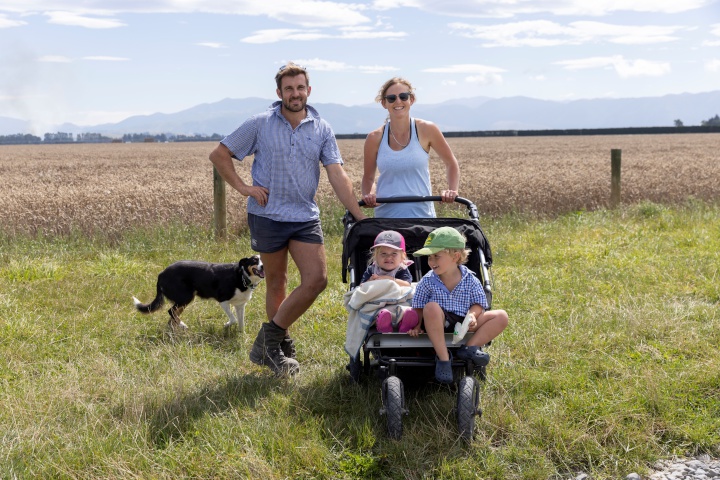N Sensor Provides Environmental And Economic Benefits

Cust farmer Roscoe Taggart is committed to creating a more efficient farming operation to enable the next generation to continue to farm. He is pictured with his wife Gracie, children Heidi, Harry, and Ollie, along with their dog Pip.
Cust farmer Roscoe Taggart has reduced his use of nitrogen fertiliser by approximately 80 kilograms this season through trialling a Yara N sensor on his family’s 730 hectare arable and sheep farm over the past two years.
Roscoe is participating in Next Generation Farming; a project to help farmers meet tough nitrate caps while maintaining their viability. As part of this project, farmers like Roscoe are using innovation and demonstrating its productivity and environmental benefits to their neighbours in the region and beyond.
Waimakariri Landcare Trust (WLT) and Waimakariri Irrigation Limited (WIL) have partnered with the Ministry for Primary Industries (MPI) for the project, with support from MPI’s Sustainable Food and Fibre Futures fund along with Environment Canterbury, Ballance, and DairyNZ.
The significant savings on fertiliser, the ease of use of the N sensor, and the environmental benefits make the N sensor a tool that Roscoe sees himself using well into the future.
“We have saved around three units of N per tonne of grain so on a twelve-tonne paddock you are saving 36 units of N per hectare which gives us an overall saving of 80 kilograms of urea for the season.
“While you are saving on costs you are also obviously lessening the impact that your farming operation is having on the environment. It is a win-win.”
Roscoe says the N sensor is quick and easy to set up with little input required before he starts applying fertiliser.
“We just put in the crop growth stage and expected yield and parameters around the limits you would like the sensor to spread to. It is remarkably simple.”
The N sensor has two operating modes; target rate mode where farmers provide the N sensor with a figure to work towards and absolute mode where the sensor fully controls the application rate by measuring the crop’s light reflectance which is connected to the crop’s biomass and chlorophyll content. The N sensor then calculates the crop’s nitrogen uptake and applies the correct amount of fertiliser directly to the plant.
Roscoe begins his first fertiliser application in target rate mode and then switches to absolute mode for subsequent applications if these are required. He has been surprised by the variability of fertiliser required by crops throughout his farm which is something that he didn’t have the ability to refine when using the previous variable rate system.
“I noticed a lot of variability in the first season, and it was not what we were expecting. Areas that I would have expected to require quite a bit of fertiliser didn’t require quite so much and then areas that I thought wouldn’t need as much ended up with a bit more.
“You must trust in the technology when you switch it to absolute mode, and it helps you become more efficient with farming when you try new things and move ahead with technology.
“It’s not just about saving money, it’s also about reducing our environmental impact and learning how technology can be a tool in the toolbox for the future.”
Meanwhile, a sustained period of rain during the crop flowering period in December caused fusarium head blight, a fungal disease which affects wheat and this along with other diseases impacted on some of Roscoe’s crops during the growth stage.
“We’ve had a mixed bag with the yield this season. Last season we had good growing conditions right up until harvest, which was extremely wet, whereas this year it rained during the growing season. However, we’ve have had good conditions during the harvest this year.”
Despite weather related issues, Roscoe has still managed to achieve above budget yields for his crops.
“The grasses have been above budget, and our clover is over budget as well. All the hybrid crops that we have harvested have also gone over budget. Overall, I think it has been a pretty good result for us.”
Roscoe will continue to focus on precision agriculture by measuring and quantifying the benefits of his N sensor over coming seasons. He believes that using technology wisely can enable efficient farming.
“Weather patterns are becoming more unpredictable, and we are seeing more extreme weather events occurring closer together than in the past. We have to look at what we can control and focus on farming as efficiently as we can.”
Video link: https://www.dropbox.com/s/st8rvz1hpn9i5x9/MPI%20-%20Innovative%20Farmers%20-%20Roscoe%20-%20Case%20Study%202%20v02%20Mar%202023.mp4?dl=0


 Hugh Grant: How To Build Confidence In The Data You Collect
Hugh Grant: How To Build Confidence In The Data You Collect Tourism Industry Aotearoa: TRENZ 2026 Set To Rediscover Auckland As It Farewells Rotorua - The Birthplace Of Tourism
Tourism Industry Aotearoa: TRENZ 2026 Set To Rediscover Auckland As It Farewells Rotorua - The Birthplace Of Tourism NIWA: Students Representing New Zealand At The ‘Olympics Of Science Fairs’ Forging Pathway For International Recognition
NIWA: Students Representing New Zealand At The ‘Olympics Of Science Fairs’ Forging Pathway For International Recognition Coalition to End Big Dairy: Activists Protest NZ National Dairy Industry Awards Again
Coalition to End Big Dairy: Activists Protest NZ National Dairy Industry Awards Again Infoblox: Dancing With Scammers - The Telegram Tango Investigation
Infoblox: Dancing With Scammers - The Telegram Tango Investigation Consumer NZ: This Mother’s Day, Give The Gift Of Scam Protection And Digital Confidence
Consumer NZ: This Mother’s Day, Give The Gift Of Scam Protection And Digital Confidence